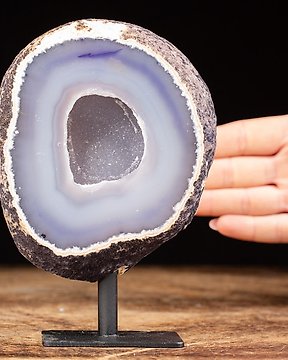
Geodo de calcedônia com cristalização interna visível - Altura: 133 mm - Largura: 115 mm- 1141 g
N.º 19717139

N.º 19717139

Rare big size 32 cm Gaucho Brazilian knife.
103 gr 925 Sterling Silver scabbard embossed with mounted Gaucho scenes with incredible detail.
Silver handle coin grade (minimum), with chased leaves and gaucho every day life elements. Belt hook has horse's head in horseshoe. Drag with oak leaves and acorns.
18cm inox blade with engraved Gaucho scenes in both sides.
Elmo hallmark, Made in Brazil.
Puñal
As a knife collector whose personal interests cover several different aspects of the fascinating world of knives, the similarities between two most interesting types of knives, Bowies and gaucho puñales, have never ceased to amaze me. Although the historic, economic and cultural milieu of North and South America followed different roads, the significance of these knives in our respective histories and cultures are of similarly great importance. In fact, the saga of the conquest of the frontier, the conflict with the Indian and the cattle industry are dominant factors in the development of both of the two Americas. Both knives suffered the early menace of restrictive laws trying to control their use. Both were principal and sometimes the only weapons for their owners. But also, they were multi-purpose tools in the hands of settlers, farmers, cowboys and gauchos. In both cases, knives were used with outstanding skill by our countrymen. There are also several features of South American knives whose exact meaning or actual use are not clear today; the same happens with certain characteristics of Bowie knives.
The use of the name puñal could be rather confusing for the historian, as the shape of this knife can not be related to the classical European poignard. Anyway, old European catalogs from the cutlery firms which supplied this kind of blade to the South American trade call them puñales or "daggers" in their literature. It is also interesting to point out that in local common day language -e.g. in a newspaper crime news- it is usually referred as a puñalada, for "stabbing." So also is the verb used to name the act of receiving a wound with an edged weapon, no matter the actual shape or type of knife used in the stabbing. It is very common among Argentine military personnel to call any type of fighting or military knife puñal without paying attention to its actual shape or design. This may somewhat explain the wide use of the word puñal among common people, referring to any kind of knife.
The so-called "Mediterranean Dagger" (actually a single-edge knife) is a knife which was used in Spain, Italy and France during the XVII and XVIII centuries and it is commonly shown as a probable origin of the early Bowie knives and is also probably connected to certain Genovese and Corsican fixed blade knives. As a matter of fact, we know that Mississippi, Louisiana and Texas received a very strong French and Spanish influence in those days and some early Bowies elicit a strong reminiscence of the European dagger or knife. This can be easily seen for example, in the classic lines of the knife Searles made for Rezin Bowie.
("A Short Essay About Gaucho Knives" by Abel A. Domenech)
Como comprar na Catawiki
1. Descubra algo especial
2. Faça a licitação vencedora
3. Faça um pagamento seguro